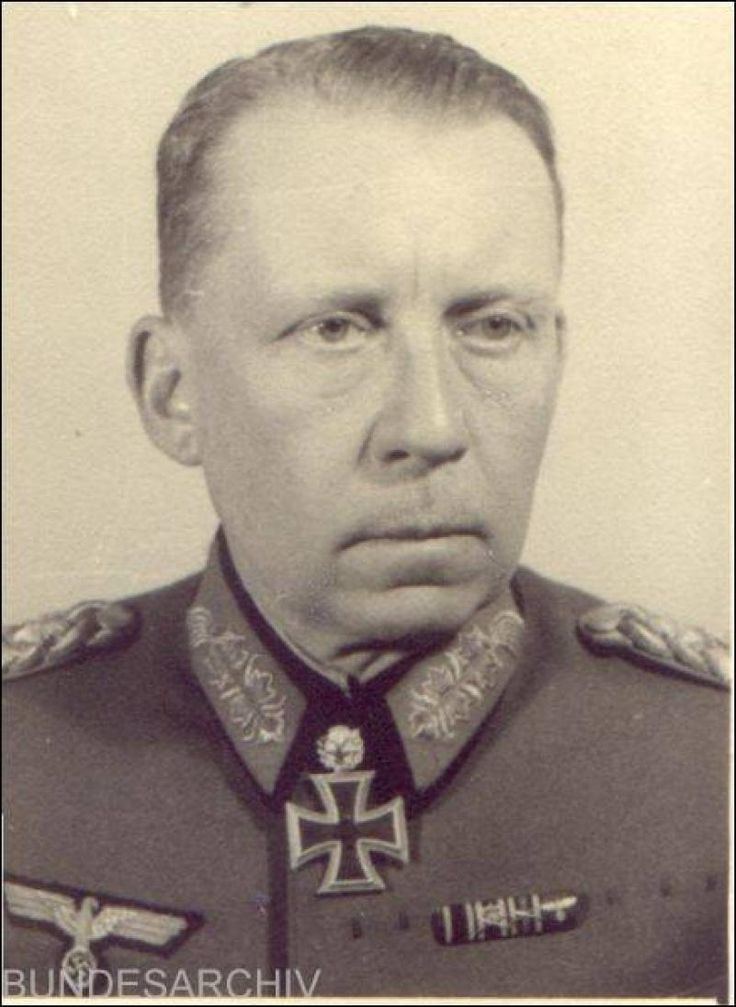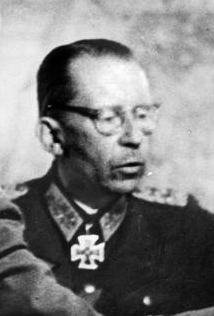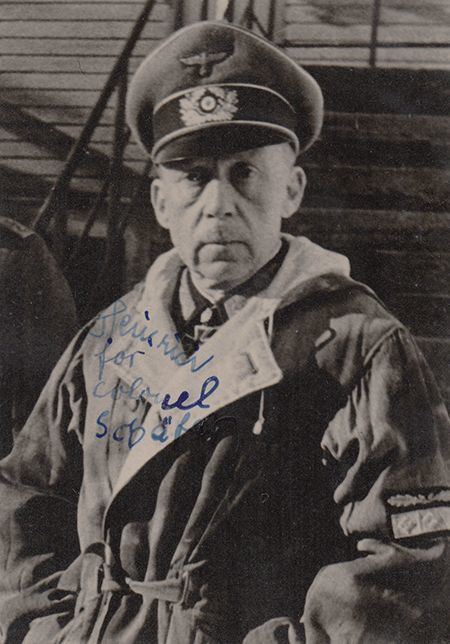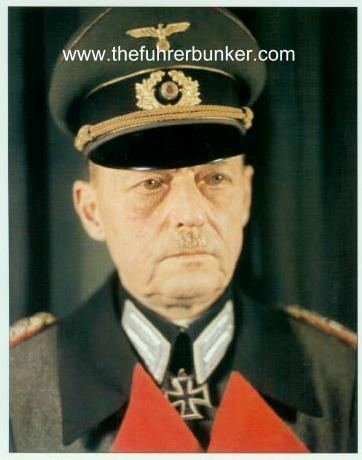Spouse Gertrude Heinrici Name Gotthard Heinrici | Rank Generaloberst Years of service 1905–45 | |
 | ||
Nickname(s) Unser Giftzwerg(literally "our poison dwarf", meaning "our tough little bastard") Born 25 December 1886Gumbinnen, Province of East Prussia, Kingdom of Prussia, German Empire now Gusev, Kaliningrad Oblast, Russian Federation ( 1886-12-25 ) Unit 95th (6th Thuringian) Infantry Regiment14th (3rd Pomeranian) Infantry Regiment203rd Infantry Division Role General officer commanding-in-chief Died December 10, 1971, Weinstadt, Germany Place of burial Freiburg im Breisgau, Germany Similar People Helmuth Weidling, Ferdinand Schorner, Ivan Konev, Kurt von Tippelskirch, Georgy Zhukov | ||
Gotthard Heinrici (25 December 1886 – 10 December 1971) was a German general during World War II. He was a recipient of the Knight's Cross of the Iron Cross with Oak Leaves and Swords of Nazi Germany. Heinrici was the commander-in-chief of the Army Group Vistula, remnants of Army Group Centre, in front of Berlin in April 1945.
Contents

Early life and career

Heinrici was born in 1886 in East Prussia, the son of a minister of the (Protestant) Evangelical Church in Germany. Following graduation from secondary school in 1905, he joined the army on 8 March 1905 as a cadet in an infantry division. From 1905 to 1906, Heinrici attended a war school. During World War I, Heinrici fought in the German invasion of Belgium and earned the Iron Cross 2nd Class in September 1914. Heinrici's division was then transferred to the Eastern Front. There, he fought in the First Battle of the Masurian Lakes and the Battle of Łódź, receiving the Iron Cross 1st Class in July 1915.

In May 1916, Heinrici took part in the Battle of Verdun. Beginning in September 1916, he served in General Staff positions with the XXIV Reserve Corps and the 115th Infantry Division. In March 1917, Heinrici was posted to the German General Staff. In September, he attended a General Staffs officer training course, and later served as a staff officer with VII Corps and the VIII Corps. In February 1918, Heinrici was posted to an infantry division, serving as a staff officer responsible for operations. In this position, he was awarded the Prussian Knight's Cross of the Royal House Order of Hohenzollern with Swords in August 1918.

Heinrici had two children, Hartmut and Gisela, with his wife Gertrude. Because Heinrici's wife Gertrude had a Jewish parent, their children were labelled Mischlinge (partly Jewish) under Nazi racial law. However, Heinrici received a "German Blood Certificate" from Hitler himself, which validated their supposed "Aryan" status and protected them from discrimination.
World War II

During the Battle of France, Heinrici's command was part of General Wilhelm Ritter von Leeb's Army Group C. He commanded the XII Army Corps which was part of the 1st Army. Heinrici's forces succeeded in breaking through the Maginot Line on 14 June 1940.

In 1941, during Operation Barbarossa, Heinrici served in the 4th Army under Günther von Kluge as the commanding general of the XXXXIII Army Corps. He received the Knight's Cross of the Iron Cross in 1941. Late in January 1942, Heinrici was given command of the 4th Army. Heinrici was awarded the Oak Leaves to his Knight's Cross on 24 November 1943. Later in 1943 he refused to obey an order to destroy the city of Smolensk by fire before the German army’s retreat, and he was temporarily dismissed from his post as commander
In the summer of 1944, after eight months of enforced retirement, Heinrici was sent to Hungary and placed in command of the 1st Panzer Army; as well as the Hungarian First Army which was attached to it. He was able to keep the First Panzer Army relatively intact as it retreated into Slovakia. Heinrici was awarded the Swords to the Oak Leaves of his Knight's Cross on 3 March 1945.
Retreat from the Oder
On 20 March 1945, Adolf Hitler replaced Heinrich Himmler with Heinrici as Commander-in-Chief of Army Group Vistula on the Eastern Front. Indicating that he was ill, Himmler had abandoned his post on 13 March and retired to a sanatorium at Hohenlychen. At this time, Army Group Vistula's front was less than 50 miles from Berlin.
Army Group Vistula consisted of two armies: the 3rd Panzer Army led by General Hasso von Manteuffel and the 9th Army led by General Theodor Busse. Heinrici was tasked with preventing a Soviet attack across the Oder River amid shortages of manpower and material. Only the terrain itself favoured Heinrici; he dug the 9th Army into three defensive lines atop Seelow Heights, overlooking the sandy, swampy banks of the Oder. Manteuffel's 3rd Panzer Army, which had fewer panzers than the 9th, was similarly positioned in the north to delay a possible flanking strike by Marshal Konstantin Rokossovsky's 2nd Byelorussian Front.
On 16 April the Battle of the Oder-Neisse began. The Soviets attacked with about 1,500,000 men for what they called the "Berlin Offensive Operation". During the Battle of Berlin, Heinrici withdrew his troops westward and made no attempt to defend the city. By late April, Heinrici ordered the retreat of his army group across the Oder River. Hitler only became aware of the retreat of Army Group Vistula around 21 April, after a puzzling request by Heinrici, who sought permission to move his headquarters to a new site, which was further west than Berlin.
Dismissal
On 28 April Field Marshal Wilhelm Keitel, commander-in-chief of the Wehrmacht, was riding along the roads north of Berlin when he noticed that troops of the 7th Panzer Division and of the 25th Panzergrenadier Division were marching north, away from Berlin. These troops were part of General Hasso von Manteuffel's 3rd Panzer Army. As one of the two armies which made up Heinrici's Army Group Vistula, it was supposed to be on its way to Berlin. Instead, Heinrici was moving it northward in an attempt to halt the Soviet breakthrough at Neubrandenburg, contrary to orders of Keitel and his deputy, General Alfred Jodl. Keitel located Heinrici on a road near Neubrandenburg, accompanied by Manteuffel. The encounter resulted in a heated confrontation that lead to Heinrici's dismissal by 29 April for disobeying orders.
Heinrici was replaced by General Kurt Student. General Kurt von Tippelskirch was named as Heinrici's interim replacement until Student could arrive and assume control of Army Group Vistula. Student was captured by the British before he could take command. The rapidly deteriorating situation that the Germans faced meant that Army Group Vistula coordination of the armies under its nominal command during the last few days of the war was of little significance.
Heinrici was dismissed by Keitel for refusing to save Hitler. He was summoned to Berlin and would have decided to do so had Captain Hellmuth Lang not persuaded him to "drive as slowly as you can" to Plön instead, informing him that he would be murdered in Berlin like Rommel (who had been Heinrici's adjutant, and later Lang's commander). Heinrici then gave himself up to British forces on 28 May.
Post-war
After his capture, Heinrici was held at Island Farm, a British prisoner of war camp at Bridgend, South Wales, where he remained, except for a three-week transfer to a camp in the United States in October 1947, until his release on 19 May 1948. After the war, Heinrici's diary entries and letters were collected into a book entitled Morals and behaviour here are like those in the Thirty Years’ War. The First Year of the German-Soviet War as Shown in the Papers of Gen. Gotthard Heinrici. He was also featured prominently in Cornelius Ryan's 1966 book, The Last Battle. Heinrici died in 1971 and was buried with full military honors at the Bergäcker cemetery in Freiburg im Breisgau.
Assessment
Married to a half-Jewish (Mischling) himself, Heinrici supported many Nazi policies including the Lebensraum concept.. On the eve of Operation Barbarossa Heinrici, on receiving the Commissar Order, justified it as easing pressure on the front lines through the exercise of "preventive terror" in the rear. As a military commander, historians described him as the premier defensive expert of the Wehrmacht and a genius admired by his peers, although little-known today because he was, in the words of Samuel W. Mitcham, "as charismatic as a 20-pound sack of fertilizer".
